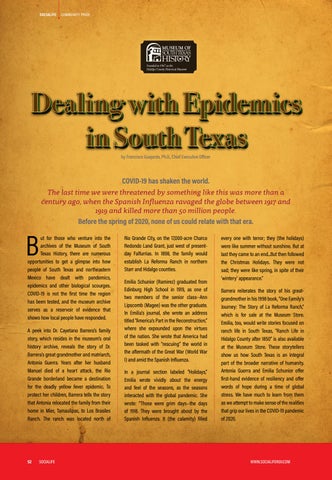SOCIALIFE
COMMUNITY PRIDE
by Francisco Guajardo, Ph.D., Chief Executive Officer
COVID-19 has shaken the world. The last time we were threatened by something like this was more than a century ago, when the Spanish Influenza ravaged the globe between 1917 and 1919 and killed more than 50 million people.
Before the spring of 2020, none of us could relate with that era.
B
ut for those who venture into the archives of the Museum of South Texas History, there are numerous opportunities to get a glimpse into how people of South Texas and northeastern Mexico have dealt with pandemics, epidemics and other biological scourges. COVID-19 is not the first time the region has been tested, and the museum archive serves as a reservoir of evidence that shows how local people have responded. A peek into Dr. Cayetano Barrera’s family story, which resides in the museum’s oral history archive, reveals the story of Dr. Barrera’s great grandmother and matriarch, Antonia Guerra. Years after her husband Manuel died of a heart attack, the Rio Grande borderland became a destination for the deadly yellow fever epidemic. To protect her children, Barrera tells the story that Antonia relocated the family from their home in Mier, Tamaulipas, to Los Brasiles Ranch. The ranch was located north of
52
SOCIALIFE
Rio Grande City, on the 17,000-acre Charco Redondo Land Grant, just west of presentday Falfurrias. In 1898, the family would establish La Reforma Ranch in northern Starr and Hidalgo counties. Emilia Schunior (Ramirez) graduated from Edinburg High School in 1919, as one of two members of the senior class--Ann Lipscomb (Magee) was the other graduate. In Emilia’s journal, she wrote an address titled “America’s Part in the Reconstruction,” where she expounded upon the virtues of the nation. She wrote that America had been tasked with “rescuing” the world in the aftermath of the Great War (World War I) and amid the Spanish Influenza. In a journal section labeled “Holidays,” Emilia wrote vividly about the energy and feel of the seasons, as the seasons interacted with the global pandemic. She wrote: “Those were grim days--the days of 1918. They were brought about by the Spanish Influenza. It (the calamity) filled
every one with terror; they (the holidays) were like summer without sunshine. But at last they came to an end...But then followed the Christmas Holidays. They were not sad; they were like spring, in spite of their ‘wintery’ appearance.” Barrera reiterates the story of his greatgrandmother in his 1998 book, “One Family’s Journey: The Story of La Reforma Ranch,” which is for sale at the Museum Store. Emilia, too, would write stories focused on ranch life in South Texas, “Ranch Life in Hidalgo County after 1850” is also available at the Museum Store. These storytellers show us how South Texas is an integral part of the broader narrative of humanity. Antonia Guerra and Emilia Schunior offer first-hand evidence of resiliency and offer words of hope during a time of global stress. We have much to learn from them as we attempt to make sense of the realities that grip our lives in the COVID-19 pandemic of 2020.
WWW.SOCIALIFERGV.COM






